University Report: Glycemic Index Analysis with C. Elegans Model
VerifiedAdded on 2022/09/14
|13
|4111
|14
Report
AI Summary
This report delves into the Glycemic Index (GI) as a ranking system for carbohydrate-containing foods, evaluating their impact on blood glucose levels. The study focuses on the role of GI in managing diabetes, highlighting the benefits of low-GI diets. The report utilizes the C. elegans model to analyze the effects of high GI foods, exploring the impact on lifespan, locomotion, and apoptosis. The literature review examines the factors influencing GI, including starch structure, processing methods, nutrient composition, and cooking methods. It also discusses the role of polyphenols and the importance of GI testing for diabetic patients. The research concludes that a high GI diet can lead to reduced lifespan and impaired locomotion in C. elegans, emphasizing the importance of dietary choices for maintaining health and preventing chronic diseases. The report emphasizes the significance of the C. elegans model in providing insights into the effects of GI on human health and proposes optimization strategies for determining GI values.

Running Head: GLYCEMIC INDEX
GLYCEMIC INDEX
Name of the Student
Name of the University
Author’s Note
GLYCEMIC INDEX
Name of the Student
Name of the University
Author’s Note
Paraphrase This Document
Need a fresh take? Get an instant paraphrase of this document with our AI Paraphraser
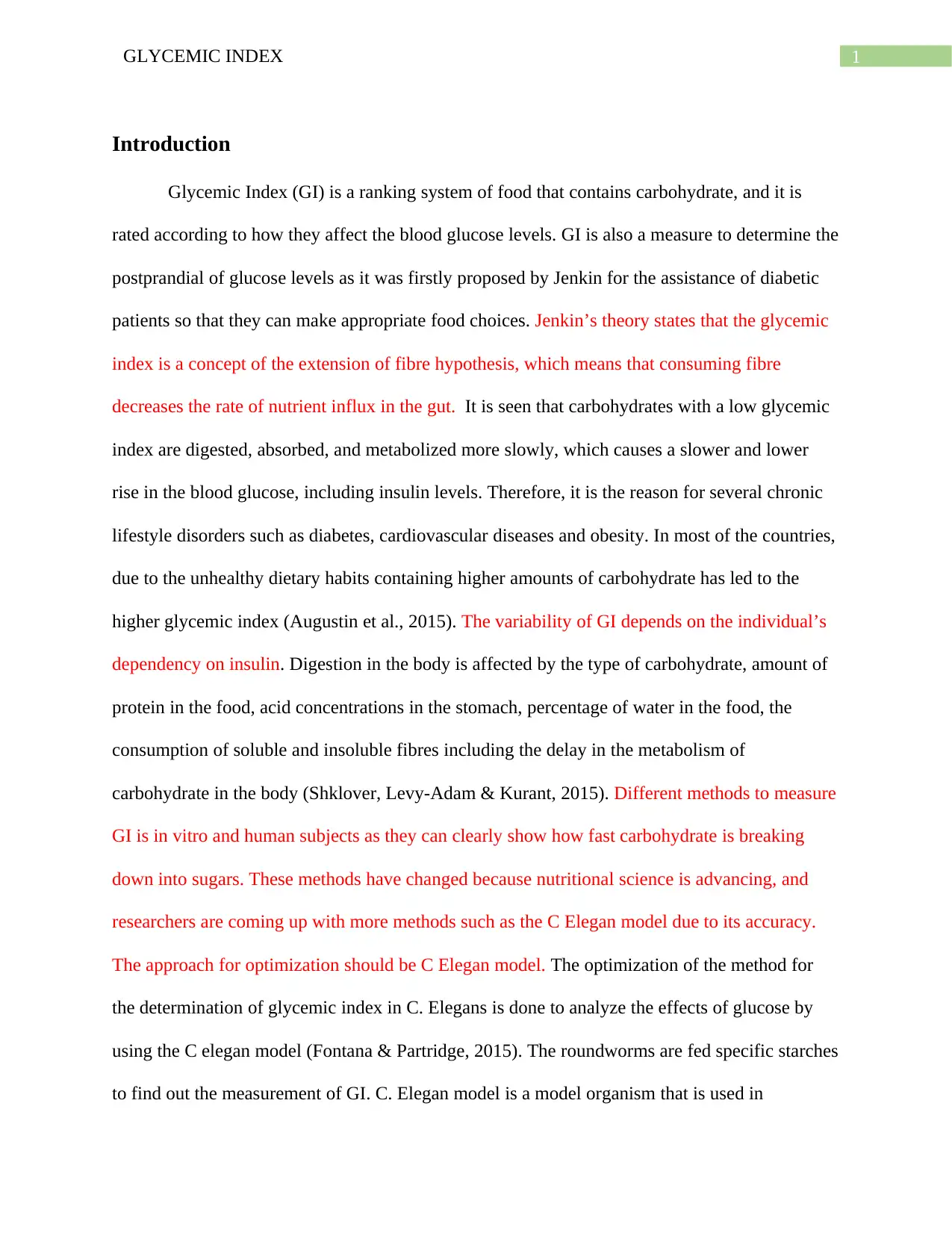
1GLYCEMIC INDEX
Introduction
Glycemic Index (GI) is a ranking system of food that contains carbohydrate, and it is
rated according to how they affect the blood glucose levels. GI is also a measure to determine the
postprandial of glucose levels as it was firstly proposed by Jenkin for the assistance of diabetic
patients so that they can make appropriate food choices. Jenkin’s theory states that the glycemic
index is a concept of the extension of fibre hypothesis, which means that consuming fibre
decreases the rate of nutrient influx in the gut. It is seen that carbohydrates with a low glycemic
index are digested, absorbed, and metabolized more slowly, which causes a slower and lower
rise in the blood glucose, including insulin levels. Therefore, it is the reason for several chronic
lifestyle disorders such as diabetes, cardiovascular diseases and obesity. In most of the countries,
due to the unhealthy dietary habits containing higher amounts of carbohydrate has led to the
higher glycemic index (Augustin et al., 2015). The variability of GI depends on the individual’s
dependency on insulin. Digestion in the body is affected by the type of carbohydrate, amount of
protein in the food, acid concentrations in the stomach, percentage of water in the food, the
consumption of soluble and insoluble fibres including the delay in the metabolism of
carbohydrate in the body (Shklover, Levy-Adam & Kurant, 2015). Different methods to measure
GI is in vitro and human subjects as they can clearly show how fast carbohydrate is breaking
down into sugars. These methods have changed because nutritional science is advancing, and
researchers are coming up with more methods such as the C Elegan model due to its accuracy.
The approach for optimization should be C Elegan model. The optimization of the method for
the determination of glycemic index in C. Elegans is done to analyze the effects of glucose by
using the C elegan model (Fontana & Partridge, 2015). The roundworms are fed specific starches
to find out the measurement of GI. C. Elegan model is a model organism that is used in
Introduction
Glycemic Index (GI) is a ranking system of food that contains carbohydrate, and it is
rated according to how they affect the blood glucose levels. GI is also a measure to determine the
postprandial of glucose levels as it was firstly proposed by Jenkin for the assistance of diabetic
patients so that they can make appropriate food choices. Jenkin’s theory states that the glycemic
index is a concept of the extension of fibre hypothesis, which means that consuming fibre
decreases the rate of nutrient influx in the gut. It is seen that carbohydrates with a low glycemic
index are digested, absorbed, and metabolized more slowly, which causes a slower and lower
rise in the blood glucose, including insulin levels. Therefore, it is the reason for several chronic
lifestyle disorders such as diabetes, cardiovascular diseases and obesity. In most of the countries,
due to the unhealthy dietary habits containing higher amounts of carbohydrate has led to the
higher glycemic index (Augustin et al., 2015). The variability of GI depends on the individual’s
dependency on insulin. Digestion in the body is affected by the type of carbohydrate, amount of
protein in the food, acid concentrations in the stomach, percentage of water in the food, the
consumption of soluble and insoluble fibres including the delay in the metabolism of
carbohydrate in the body (Shklover, Levy-Adam & Kurant, 2015). Different methods to measure
GI is in vitro and human subjects as they can clearly show how fast carbohydrate is breaking
down into sugars. These methods have changed because nutritional science is advancing, and
researchers are coming up with more methods such as the C Elegan model due to its accuracy.
The approach for optimization should be C Elegan model. The optimization of the method for
the determination of glycemic index in C. Elegans is done to analyze the effects of glucose by
using the C elegan model (Fontana & Partridge, 2015). The roundworms are fed specific starches
to find out the measurement of GI. C. Elegan model is a model organism that is used in
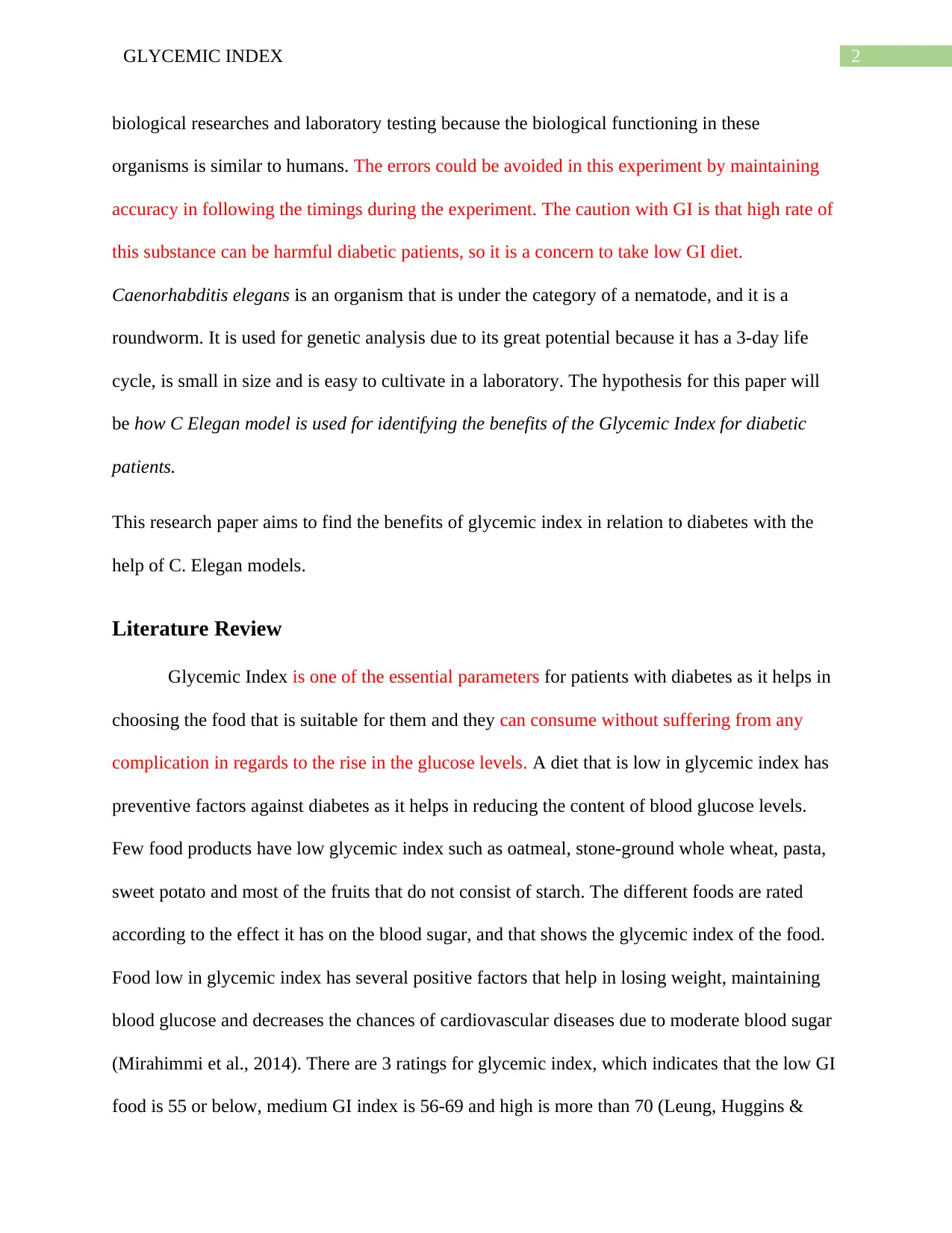
2GLYCEMIC INDEX
biological researches and laboratory testing because the biological functioning in these
organisms is similar to humans. The errors could be avoided in this experiment by maintaining
accuracy in following the timings during the experiment. The caution with GI is that high rate of
this substance can be harmful diabetic patients, so it is a concern to take low GI diet.
Caenorhabditis elegans is an organism that is under the category of a nematode, and it is a
roundworm. It is used for genetic analysis due to its great potential because it has a 3-day life
cycle, is small in size and is easy to cultivate in a laboratory. The hypothesis for this paper will
be how C Elegan model is used for identifying the benefits of the Glycemic Index for diabetic
patients.
This research paper aims to find the benefits of glycemic index in relation to diabetes with the
help of C. Elegan models.
Literature Review
Glycemic Index is one of the essential parameters for patients with diabetes as it helps in
choosing the food that is suitable for them and they can consume without suffering from any
complication in regards to the rise in the glucose levels. A diet that is low in glycemic index has
preventive factors against diabetes as it helps in reducing the content of blood glucose levels.
Few food products have low glycemic index such as oatmeal, stone-ground whole wheat, pasta,
sweet potato and most of the fruits that do not consist of starch. The different foods are rated
according to the effect it has on the blood sugar, and that shows the glycemic index of the food.
Food low in glycemic index has several positive factors that help in losing weight, maintaining
blood glucose and decreases the chances of cardiovascular diseases due to moderate blood sugar
(Mirahimmi et al., 2014). There are 3 ratings for glycemic index, which indicates that the low GI
food is 55 or below, medium GI index is 56-69 and high is more than 70 (Leung, Huggins &
biological researches and laboratory testing because the biological functioning in these
organisms is similar to humans. The errors could be avoided in this experiment by maintaining
accuracy in following the timings during the experiment. The caution with GI is that high rate of
this substance can be harmful diabetic patients, so it is a concern to take low GI diet.
Caenorhabditis elegans is an organism that is under the category of a nematode, and it is a
roundworm. It is used for genetic analysis due to its great potential because it has a 3-day life
cycle, is small in size and is easy to cultivate in a laboratory. The hypothesis for this paper will
be how C Elegan model is used for identifying the benefits of the Glycemic Index for diabetic
patients.
This research paper aims to find the benefits of glycemic index in relation to diabetes with the
help of C. Elegan models.
Literature Review
Glycemic Index is one of the essential parameters for patients with diabetes as it helps in
choosing the food that is suitable for them and they can consume without suffering from any
complication in regards to the rise in the glucose levels. A diet that is low in glycemic index has
preventive factors against diabetes as it helps in reducing the content of blood glucose levels.
Few food products have low glycemic index such as oatmeal, stone-ground whole wheat, pasta,
sweet potato and most of the fruits that do not consist of starch. The different foods are rated
according to the effect it has on the blood sugar, and that shows the glycemic index of the food.
Food low in glycemic index has several positive factors that help in losing weight, maintaining
blood glucose and decreases the chances of cardiovascular diseases due to moderate blood sugar
(Mirahimmi et al., 2014). There are 3 ratings for glycemic index, which indicates that the low GI
food is 55 or below, medium GI index is 56-69 and high is more than 70 (Leung, Huggins &
⊘ This is a preview!⊘
Do you want full access?
Subscribe today to unlock all pages.

Trusted by 1+ million students worldwide
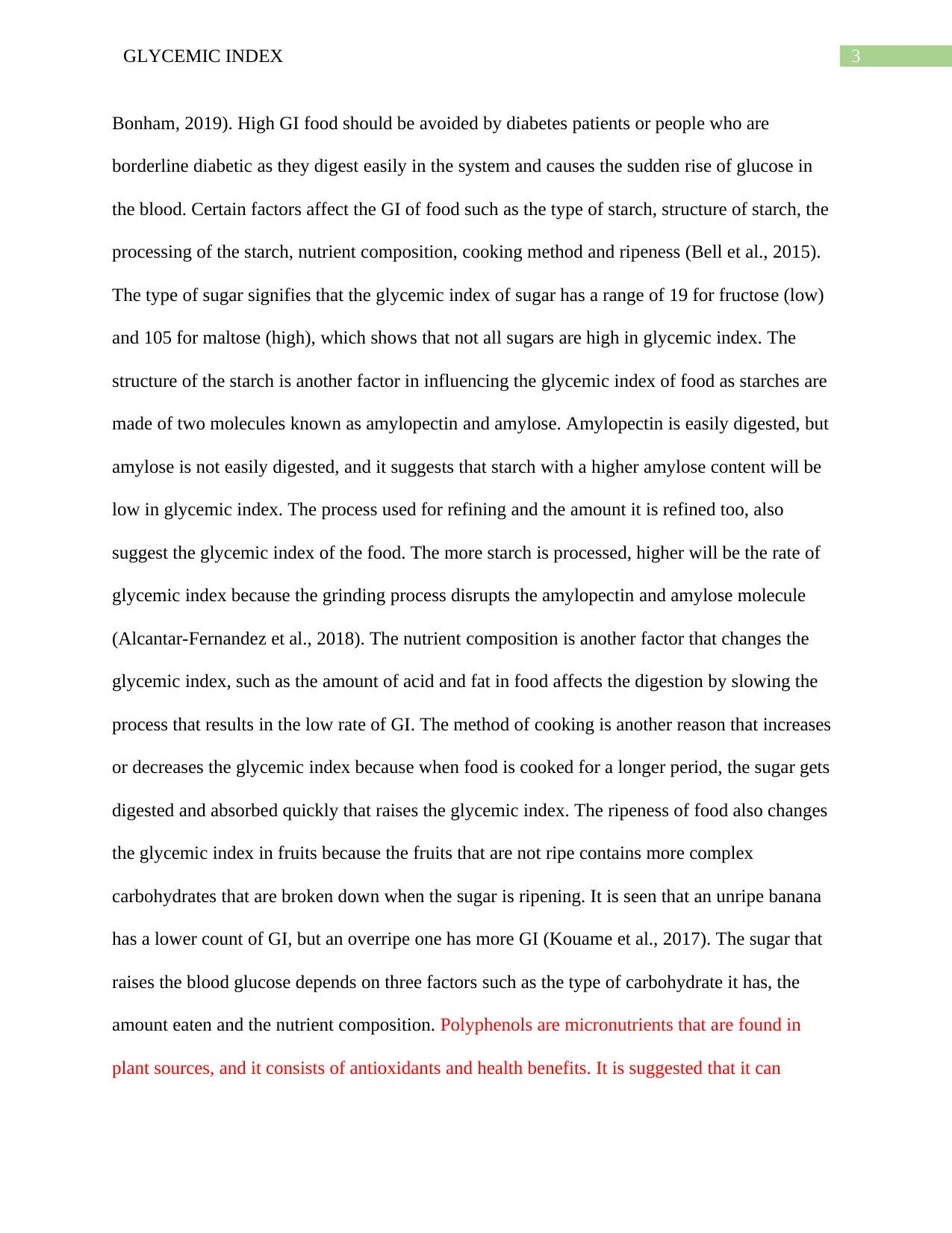
3GLYCEMIC INDEX
Bonham, 2019). High GI food should be avoided by diabetes patients or people who are
borderline diabetic as they digest easily in the system and causes the sudden rise of glucose in
the blood. Certain factors affect the GI of food such as the type of starch, structure of starch, the
processing of the starch, nutrient composition, cooking method and ripeness (Bell et al., 2015).
The type of sugar signifies that the glycemic index of sugar has a range of 19 for fructose (low)
and 105 for maltose (high), which shows that not all sugars are high in glycemic index. The
structure of the starch is another factor in influencing the glycemic index of food as starches are
made of two molecules known as amylopectin and amylose. Amylopectin is easily digested, but
amylose is not easily digested, and it suggests that starch with a higher amylose content will be
low in glycemic index. The process used for refining and the amount it is refined too, also
suggest the glycemic index of the food. The more starch is processed, higher will be the rate of
glycemic index because the grinding process disrupts the amylopectin and amylose molecule
(Alcantar-Fernandez et al., 2018). The nutrient composition is another factor that changes the
glycemic index, such as the amount of acid and fat in food affects the digestion by slowing the
process that results in the low rate of GI. The method of cooking is another reason that increases
or decreases the glycemic index because when food is cooked for a longer period, the sugar gets
digested and absorbed quickly that raises the glycemic index. The ripeness of food also changes
the glycemic index in fruits because the fruits that are not ripe contains more complex
carbohydrates that are broken down when the sugar is ripening. It is seen that an unripe banana
has a lower count of GI, but an overripe one has more GI (Kouame et al., 2017). The sugar that
raises the blood glucose depends on three factors such as the type of carbohydrate it has, the
amount eaten and the nutrient composition. Polyphenols are micronutrients that are found in
plant sources, and it consists of antioxidants and health benefits. It is suggested that it can
Bonham, 2019). High GI food should be avoided by diabetes patients or people who are
borderline diabetic as they digest easily in the system and causes the sudden rise of glucose in
the blood. Certain factors affect the GI of food such as the type of starch, structure of starch, the
processing of the starch, nutrient composition, cooking method and ripeness (Bell et al., 2015).
The type of sugar signifies that the glycemic index of sugar has a range of 19 for fructose (low)
and 105 for maltose (high), which shows that not all sugars are high in glycemic index. The
structure of the starch is another factor in influencing the glycemic index of food as starches are
made of two molecules known as amylopectin and amylose. Amylopectin is easily digested, but
amylose is not easily digested, and it suggests that starch with a higher amylose content will be
low in glycemic index. The process used for refining and the amount it is refined too, also
suggest the glycemic index of the food. The more starch is processed, higher will be the rate of
glycemic index because the grinding process disrupts the amylopectin and amylose molecule
(Alcantar-Fernandez et al., 2018). The nutrient composition is another factor that changes the
glycemic index, such as the amount of acid and fat in food affects the digestion by slowing the
process that results in the low rate of GI. The method of cooking is another reason that increases
or decreases the glycemic index because when food is cooked for a longer period, the sugar gets
digested and absorbed quickly that raises the glycemic index. The ripeness of food also changes
the glycemic index in fruits because the fruits that are not ripe contains more complex
carbohydrates that are broken down when the sugar is ripening. It is seen that an unripe banana
has a lower count of GI, but an overripe one has more GI (Kouame et al., 2017). The sugar that
raises the blood glucose depends on three factors such as the type of carbohydrate it has, the
amount eaten and the nutrient composition. Polyphenols are micronutrients that are found in
plant sources, and it consists of antioxidants and health benefits. It is suggested that it can
Paraphrase This Document
Need a fresh take? Get an instant paraphrase of this document with our AI Paraphraser
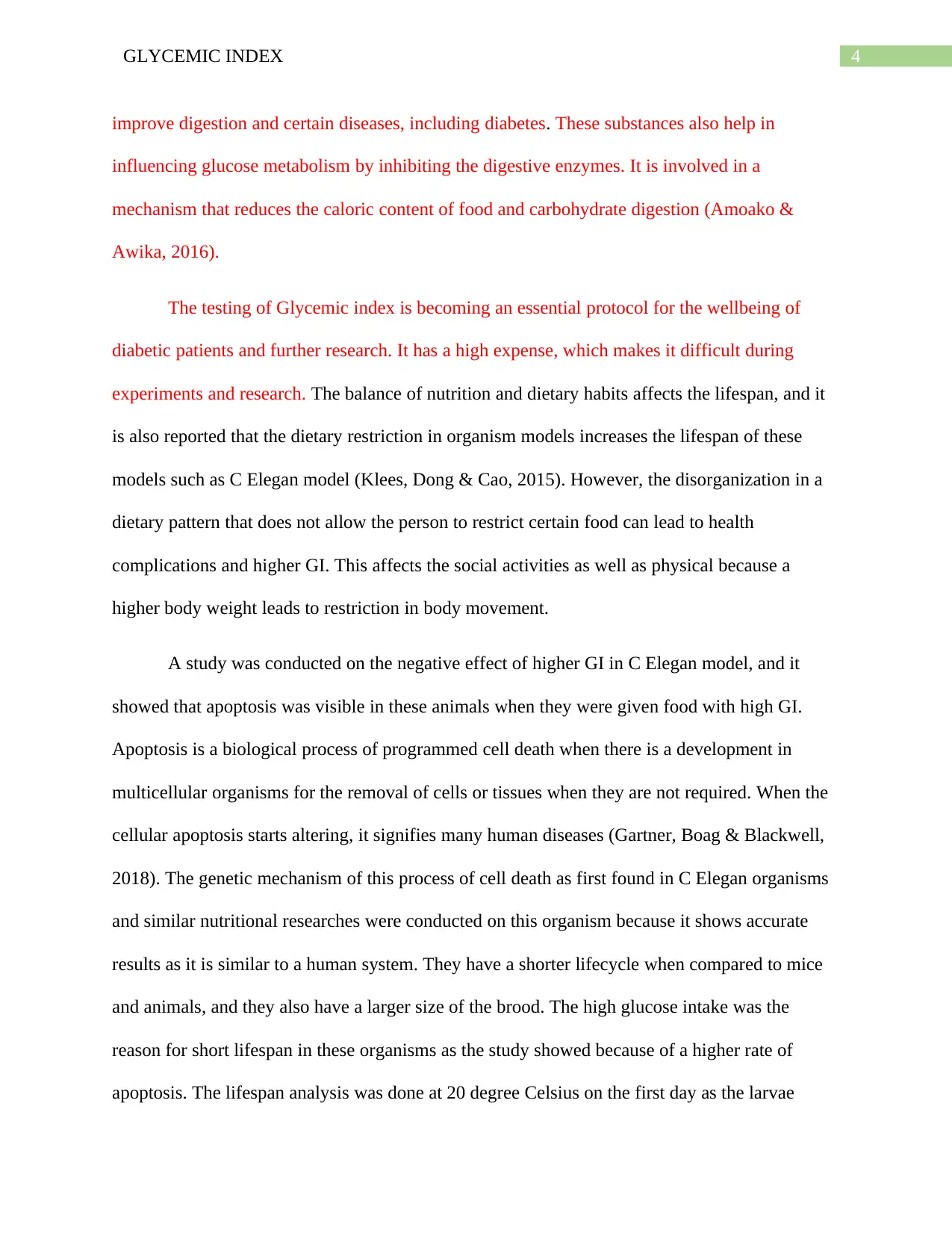
4GLYCEMIC INDEX
improve digestion and certain diseases, including diabetes. These substances also help in
influencing glucose metabolism by inhibiting the digestive enzymes. It is involved in a
mechanism that reduces the caloric content of food and carbohydrate digestion (Amoako &
Awika, 2016).
The testing of Glycemic index is becoming an essential protocol for the wellbeing of
diabetic patients and further research. It has a high expense, which makes it difficult during
experiments and research. The balance of nutrition and dietary habits affects the lifespan, and it
is also reported that the dietary restriction in organism models increases the lifespan of these
models such as C Elegan model (Klees, Dong & Cao, 2015). However, the disorganization in a
dietary pattern that does not allow the person to restrict certain food can lead to health
complications and higher GI. This affects the social activities as well as physical because a
higher body weight leads to restriction in body movement.
A study was conducted on the negative effect of higher GI in C Elegan model, and it
showed that apoptosis was visible in these animals when they were given food with high GI.
Apoptosis is a biological process of programmed cell death when there is a development in
multicellular organisms for the removal of cells or tissues when they are not required. When the
cellular apoptosis starts altering, it signifies many human diseases (Gartner, Boag & Blackwell,
2018). The genetic mechanism of this process of cell death as first found in C Elegan organisms
and similar nutritional researches were conducted on this organism because it shows accurate
results as it is similar to a human system. They have a shorter lifecycle when compared to mice
and animals, and they also have a larger size of the brood. The high glucose intake was the
reason for short lifespan in these organisms as the study showed because of a higher rate of
apoptosis. The lifespan analysis was done at 20 degree Celsius on the first day as the larvae
improve digestion and certain diseases, including diabetes. These substances also help in
influencing glucose metabolism by inhibiting the digestive enzymes. It is involved in a
mechanism that reduces the caloric content of food and carbohydrate digestion (Amoako &
Awika, 2016).
The testing of Glycemic index is becoming an essential protocol for the wellbeing of
diabetic patients and further research. It has a high expense, which makes it difficult during
experiments and research. The balance of nutrition and dietary habits affects the lifespan, and it
is also reported that the dietary restriction in organism models increases the lifespan of these
models such as C Elegan model (Klees, Dong & Cao, 2015). However, the disorganization in a
dietary pattern that does not allow the person to restrict certain food can lead to health
complications and higher GI. This affects the social activities as well as physical because a
higher body weight leads to restriction in body movement.
A study was conducted on the negative effect of higher GI in C Elegan model, and it
showed that apoptosis was visible in these animals when they were given food with high GI.
Apoptosis is a biological process of programmed cell death when there is a development in
multicellular organisms for the removal of cells or tissues when they are not required. When the
cellular apoptosis starts altering, it signifies many human diseases (Gartner, Boag & Blackwell,
2018). The genetic mechanism of this process of cell death as first found in C Elegan organisms
and similar nutritional researches were conducted on this organism because it shows accurate
results as it is similar to a human system. They have a shorter lifecycle when compared to mice
and animals, and they also have a larger size of the brood. The high glucose intake was the
reason for short lifespan in these organisms as the study showed because of a higher rate of
apoptosis. The lifespan analysis was done at 20 degree Celsius on the first day as the larvae
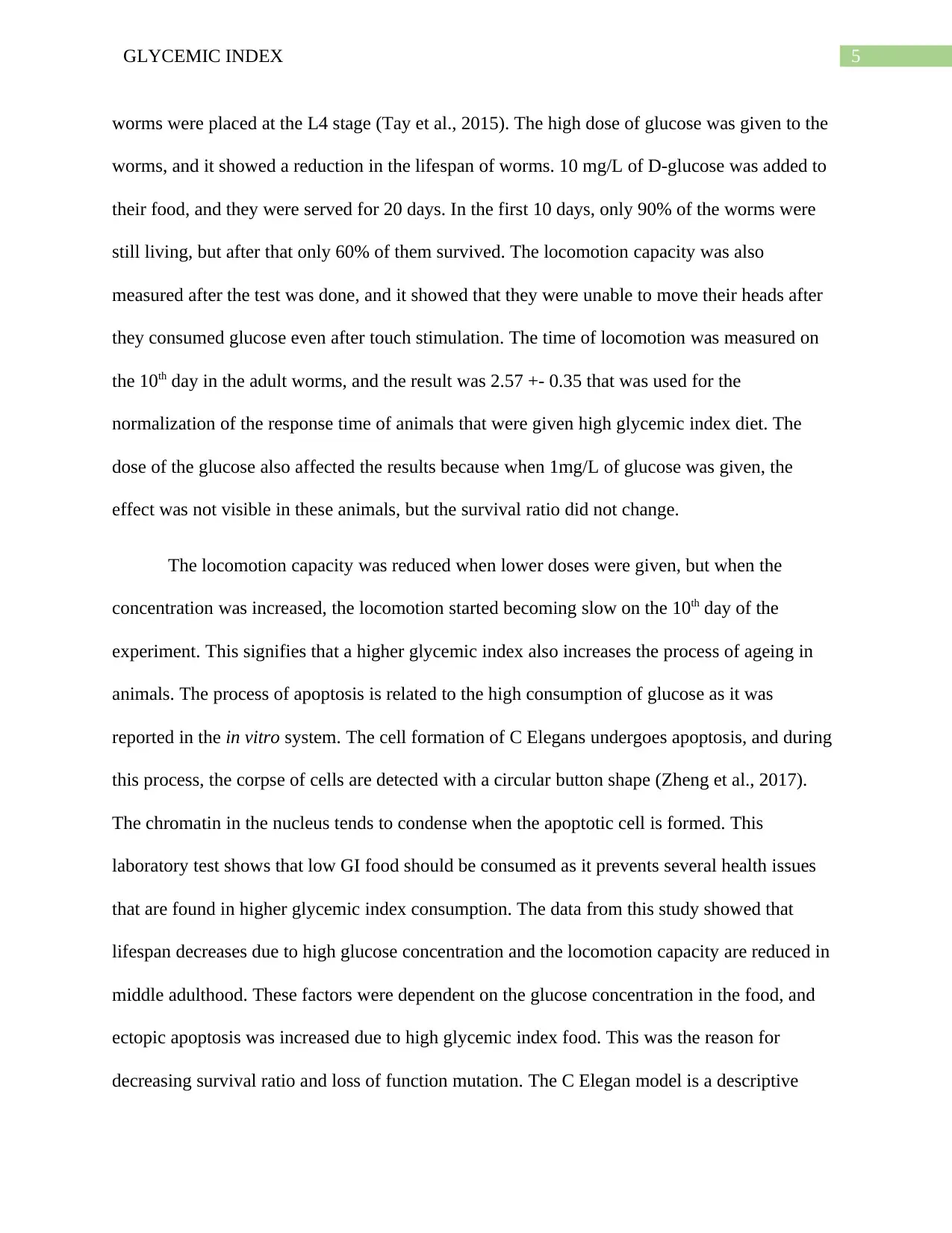
5GLYCEMIC INDEX
worms were placed at the L4 stage (Tay et al., 2015). The high dose of glucose was given to the
worms, and it showed a reduction in the lifespan of worms. 10 mg/L of D-glucose was added to
their food, and they were served for 20 days. In the first 10 days, only 90% of the worms were
still living, but after that only 60% of them survived. The locomotion capacity was also
measured after the test was done, and it showed that they were unable to move their heads after
they consumed glucose even after touch stimulation. The time of locomotion was measured on
the 10th day in the adult worms, and the result was 2.57 +- 0.35 that was used for the
normalization of the response time of animals that were given high glycemic index diet. The
dose of the glucose also affected the results because when 1mg/L of glucose was given, the
effect was not visible in these animals, but the survival ratio did not change.
The locomotion capacity was reduced when lower doses were given, but when the
concentration was increased, the locomotion started becoming slow on the 10th day of the
experiment. This signifies that a higher glycemic index also increases the process of ageing in
animals. The process of apoptosis is related to the high consumption of glucose as it was
reported in the in vitro system. The cell formation of C Elegans undergoes apoptosis, and during
this process, the corpse of cells are detected with a circular button shape (Zheng et al., 2017).
The chromatin in the nucleus tends to condense when the apoptotic cell is formed. This
laboratory test shows that low GI food should be consumed as it prevents several health issues
that are found in higher glycemic index consumption. The data from this study showed that
lifespan decreases due to high glucose concentration and the locomotion capacity are reduced in
middle adulthood. These factors were dependent on the glucose concentration in the food, and
ectopic apoptosis was increased due to high glycemic index food. This was the reason for
decreasing survival ratio and loss of function mutation. The C Elegan model is a descriptive
worms were placed at the L4 stage (Tay et al., 2015). The high dose of glucose was given to the
worms, and it showed a reduction in the lifespan of worms. 10 mg/L of D-glucose was added to
their food, and they were served for 20 days. In the first 10 days, only 90% of the worms were
still living, but after that only 60% of them survived. The locomotion capacity was also
measured after the test was done, and it showed that they were unable to move their heads after
they consumed glucose even after touch stimulation. The time of locomotion was measured on
the 10th day in the adult worms, and the result was 2.57 +- 0.35 that was used for the
normalization of the response time of animals that were given high glycemic index diet. The
dose of the glucose also affected the results because when 1mg/L of glucose was given, the
effect was not visible in these animals, but the survival ratio did not change.
The locomotion capacity was reduced when lower doses were given, but when the
concentration was increased, the locomotion started becoming slow on the 10th day of the
experiment. This signifies that a higher glycemic index also increases the process of ageing in
animals. The process of apoptosis is related to the high consumption of glucose as it was
reported in the in vitro system. The cell formation of C Elegans undergoes apoptosis, and during
this process, the corpse of cells are detected with a circular button shape (Zheng et al., 2017).
The chromatin in the nucleus tends to condense when the apoptotic cell is formed. This
laboratory test shows that low GI food should be consumed as it prevents several health issues
that are found in higher glycemic index consumption. The data from this study showed that
lifespan decreases due to high glucose concentration and the locomotion capacity are reduced in
middle adulthood. These factors were dependent on the glucose concentration in the food, and
ectopic apoptosis was increased due to high glycemic index food. This was the reason for
decreasing survival ratio and loss of function mutation. The C Elegan model is a descriptive
⊘ This is a preview!⊘
Do you want full access?
Subscribe today to unlock all pages.

Trusted by 1+ million students worldwide
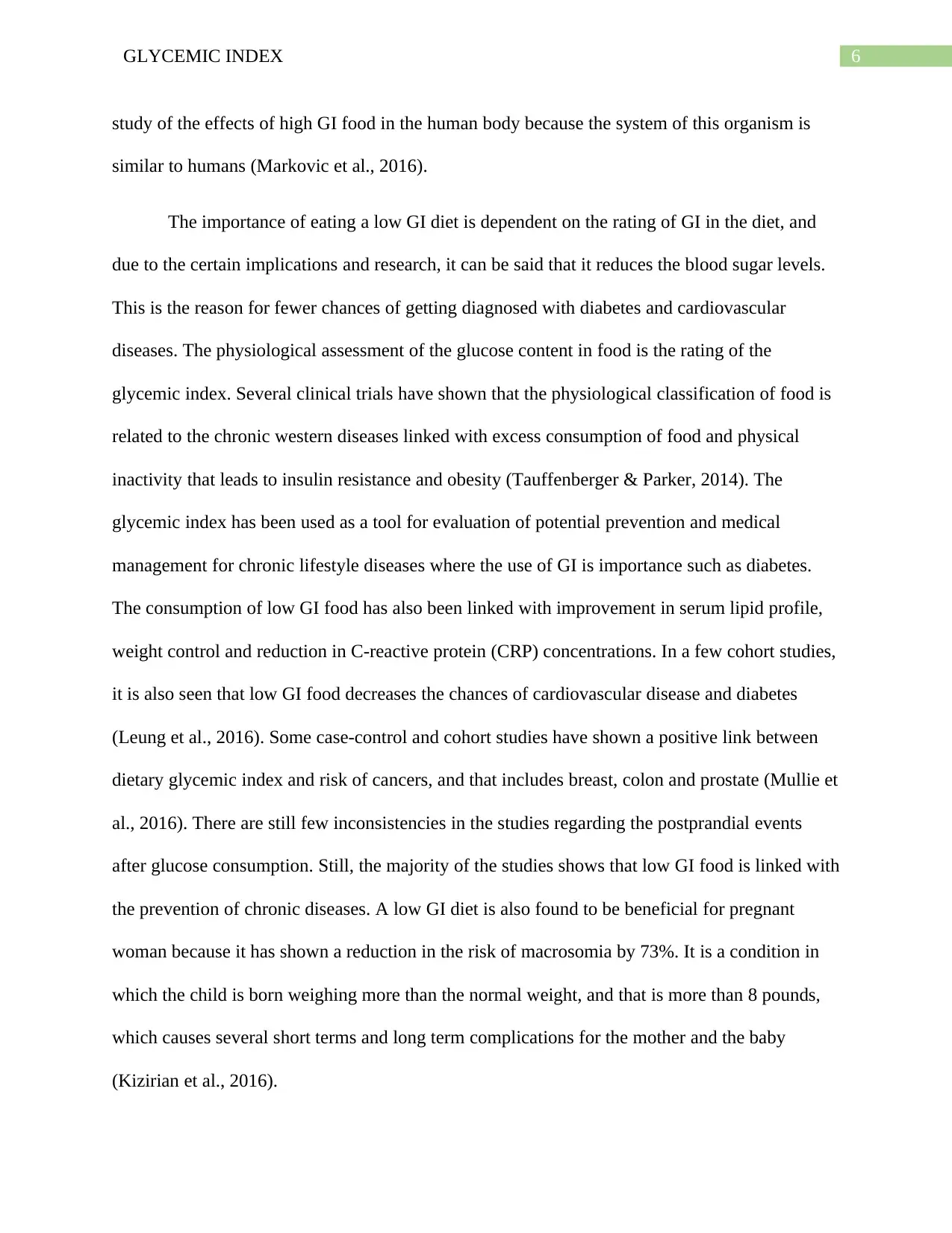
6GLYCEMIC INDEX
study of the effects of high GI food in the human body because the system of this organism is
similar to humans (Markovic et al., 2016).
The importance of eating a low GI diet is dependent on the rating of GI in the diet, and
due to the certain implications and research, it can be said that it reduces the blood sugar levels.
This is the reason for fewer chances of getting diagnosed with diabetes and cardiovascular
diseases. The physiological assessment of the glucose content in food is the rating of the
glycemic index. Several clinical trials have shown that the physiological classification of food is
related to the chronic western diseases linked with excess consumption of food and physical
inactivity that leads to insulin resistance and obesity (Tauffenberger & Parker, 2014). The
glycemic index has been used as a tool for evaluation of potential prevention and medical
management for chronic lifestyle diseases where the use of GI is importance such as diabetes.
The consumption of low GI food has also been linked with improvement in serum lipid profile,
weight control and reduction in C-reactive protein (CRP) concentrations. In a few cohort studies,
it is also seen that low GI food decreases the chances of cardiovascular disease and diabetes
(Leung et al., 2016). Some case-control and cohort studies have shown a positive link between
dietary glycemic index and risk of cancers, and that includes breast, colon and prostate (Mullie et
al., 2016). There are still few inconsistencies in the studies regarding the postprandial events
after glucose consumption. Still, the majority of the studies shows that low GI food is linked with
the prevention of chronic diseases. A low GI diet is also found to be beneficial for pregnant
woman because it has shown a reduction in the risk of macrosomia by 73%. It is a condition in
which the child is born weighing more than the normal weight, and that is more than 8 pounds,
which causes several short terms and long term complications for the mother and the baby
(Kizirian et al., 2016).
study of the effects of high GI food in the human body because the system of this organism is
similar to humans (Markovic et al., 2016).
The importance of eating a low GI diet is dependent on the rating of GI in the diet, and
due to the certain implications and research, it can be said that it reduces the blood sugar levels.
This is the reason for fewer chances of getting diagnosed with diabetes and cardiovascular
diseases. The physiological assessment of the glucose content in food is the rating of the
glycemic index. Several clinical trials have shown that the physiological classification of food is
related to the chronic western diseases linked with excess consumption of food and physical
inactivity that leads to insulin resistance and obesity (Tauffenberger & Parker, 2014). The
glycemic index has been used as a tool for evaluation of potential prevention and medical
management for chronic lifestyle diseases where the use of GI is importance such as diabetes.
The consumption of low GI food has also been linked with improvement in serum lipid profile,
weight control and reduction in C-reactive protein (CRP) concentrations. In a few cohort studies,
it is also seen that low GI food decreases the chances of cardiovascular disease and diabetes
(Leung et al., 2016). Some case-control and cohort studies have shown a positive link between
dietary glycemic index and risk of cancers, and that includes breast, colon and prostate (Mullie et
al., 2016). There are still few inconsistencies in the studies regarding the postprandial events
after glucose consumption. Still, the majority of the studies shows that low GI food is linked with
the prevention of chronic diseases. A low GI diet is also found to be beneficial for pregnant
woman because it has shown a reduction in the risk of macrosomia by 73%. It is a condition in
which the child is born weighing more than the normal weight, and that is more than 8 pounds,
which causes several short terms and long term complications for the mother and the baby
(Kizirian et al., 2016).
Paraphrase This Document
Need a fresh take? Get an instant paraphrase of this document with our AI Paraphraser
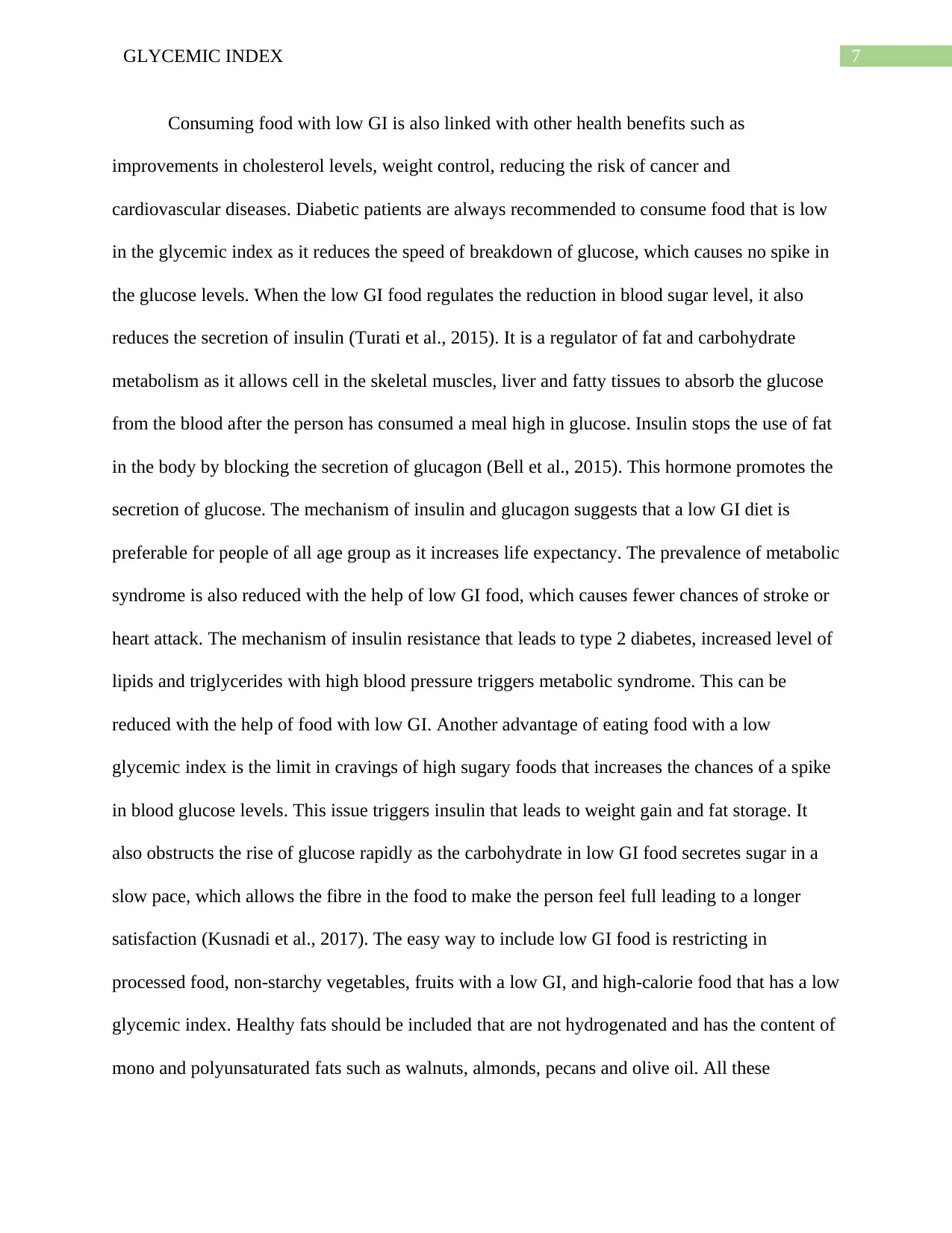
7GLYCEMIC INDEX
Consuming food with low GI is also linked with other health benefits such as
improvements in cholesterol levels, weight control, reducing the risk of cancer and
cardiovascular diseases. Diabetic patients are always recommended to consume food that is low
in the glycemic index as it reduces the speed of breakdown of glucose, which causes no spike in
the glucose levels. When the low GI food regulates the reduction in blood sugar level, it also
reduces the secretion of insulin (Turati et al., 2015). It is a regulator of fat and carbohydrate
metabolism as it allows cell in the skeletal muscles, liver and fatty tissues to absorb the glucose
from the blood after the person has consumed a meal high in glucose. Insulin stops the use of fat
in the body by blocking the secretion of glucagon (Bell et al., 2015). This hormone promotes the
secretion of glucose. The mechanism of insulin and glucagon suggests that a low GI diet is
preferable for people of all age group as it increases life expectancy. The prevalence of metabolic
syndrome is also reduced with the help of low GI food, which causes fewer chances of stroke or
heart attack. The mechanism of insulin resistance that leads to type 2 diabetes, increased level of
lipids and triglycerides with high blood pressure triggers metabolic syndrome. This can be
reduced with the help of food with low GI. Another advantage of eating food with a low
glycemic index is the limit in cravings of high sugary foods that increases the chances of a spike
in blood glucose levels. This issue triggers insulin that leads to weight gain and fat storage. It
also obstructs the rise of glucose rapidly as the carbohydrate in low GI food secretes sugar in a
slow pace, which allows the fibre in the food to make the person feel full leading to a longer
satisfaction (Kusnadi et al., 2017). The easy way to include low GI food is restricting in
processed food, non-starchy vegetables, fruits with a low GI, and high-calorie food that has a low
glycemic index. Healthy fats should be included that are not hydrogenated and has the content of
mono and polyunsaturated fats such as walnuts, almonds, pecans and olive oil. All these
Consuming food with low GI is also linked with other health benefits such as
improvements in cholesterol levels, weight control, reducing the risk of cancer and
cardiovascular diseases. Diabetic patients are always recommended to consume food that is low
in the glycemic index as it reduces the speed of breakdown of glucose, which causes no spike in
the glucose levels. When the low GI food regulates the reduction in blood sugar level, it also
reduces the secretion of insulin (Turati et al., 2015). It is a regulator of fat and carbohydrate
metabolism as it allows cell in the skeletal muscles, liver and fatty tissues to absorb the glucose
from the blood after the person has consumed a meal high in glucose. Insulin stops the use of fat
in the body by blocking the secretion of glucagon (Bell et al., 2015). This hormone promotes the
secretion of glucose. The mechanism of insulin and glucagon suggests that a low GI diet is
preferable for people of all age group as it increases life expectancy. The prevalence of metabolic
syndrome is also reduced with the help of low GI food, which causes fewer chances of stroke or
heart attack. The mechanism of insulin resistance that leads to type 2 diabetes, increased level of
lipids and triglycerides with high blood pressure triggers metabolic syndrome. This can be
reduced with the help of food with low GI. Another advantage of eating food with a low
glycemic index is the limit in cravings of high sugary foods that increases the chances of a spike
in blood glucose levels. This issue triggers insulin that leads to weight gain and fat storage. It
also obstructs the rise of glucose rapidly as the carbohydrate in low GI food secretes sugar in a
slow pace, which allows the fibre in the food to make the person feel full leading to a longer
satisfaction (Kusnadi et al., 2017). The easy way to include low GI food is restricting in
processed food, non-starchy vegetables, fruits with a low GI, and high-calorie food that has a low
glycemic index. Healthy fats should be included that are not hydrogenated and has the content of
mono and polyunsaturated fats such as walnuts, almonds, pecans and olive oil. All these
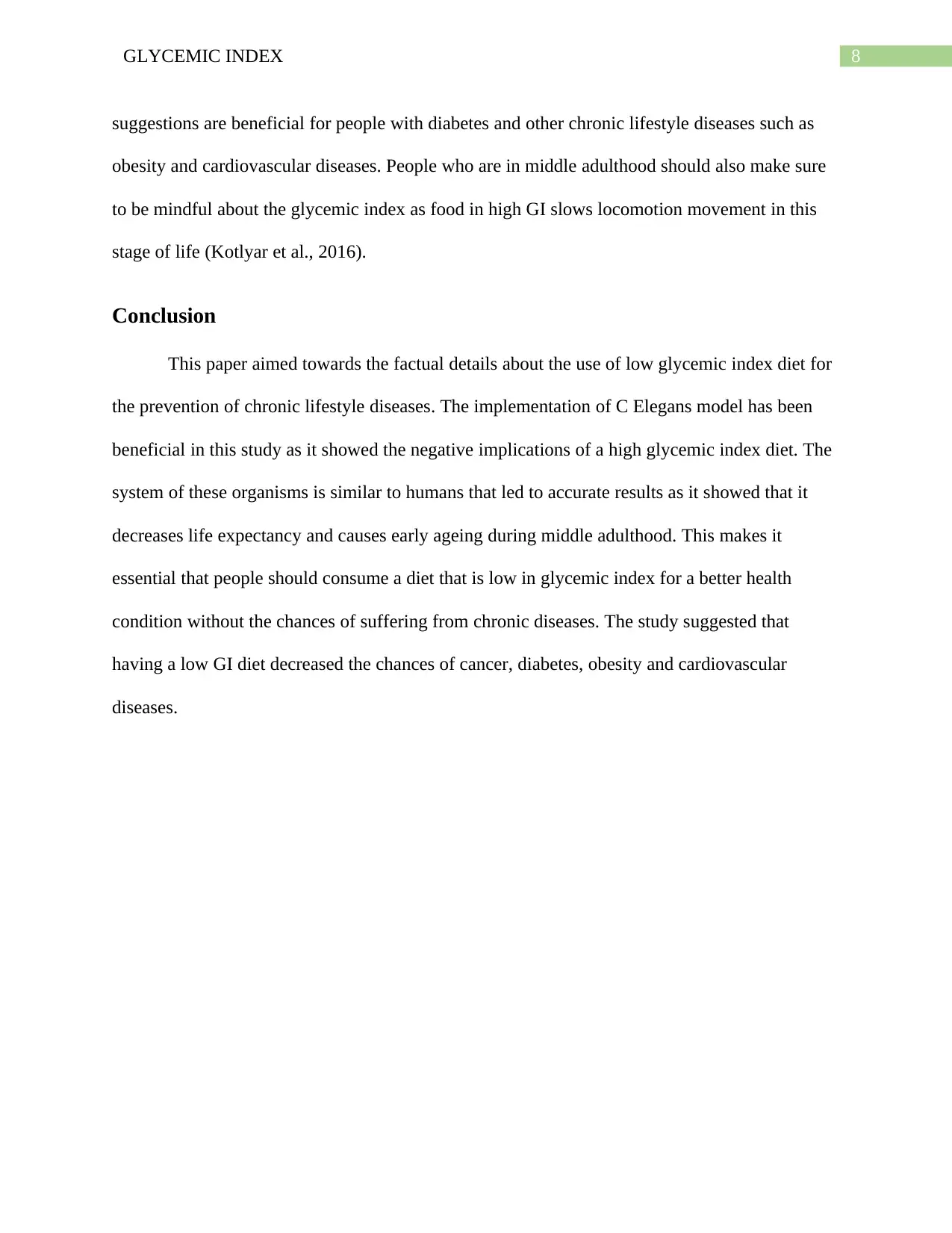
8GLYCEMIC INDEX
suggestions are beneficial for people with diabetes and other chronic lifestyle diseases such as
obesity and cardiovascular diseases. People who are in middle adulthood should also make sure
to be mindful about the glycemic index as food in high GI slows locomotion movement in this
stage of life (Kotlyar et al., 2016).
Conclusion
This paper aimed towards the factual details about the use of low glycemic index diet for
the prevention of chronic lifestyle diseases. The implementation of C Elegans model has been
beneficial in this study as it showed the negative implications of a high glycemic index diet. The
system of these organisms is similar to humans that led to accurate results as it showed that it
decreases life expectancy and causes early ageing during middle adulthood. This makes it
essential that people should consume a diet that is low in glycemic index for a better health
condition without the chances of suffering from chronic diseases. The study suggested that
having a low GI diet decreased the chances of cancer, diabetes, obesity and cardiovascular
diseases.
suggestions are beneficial for people with diabetes and other chronic lifestyle diseases such as
obesity and cardiovascular diseases. People who are in middle adulthood should also make sure
to be mindful about the glycemic index as food in high GI slows locomotion movement in this
stage of life (Kotlyar et al., 2016).
Conclusion
This paper aimed towards the factual details about the use of low glycemic index diet for
the prevention of chronic lifestyle diseases. The implementation of C Elegans model has been
beneficial in this study as it showed the negative implications of a high glycemic index diet. The
system of these organisms is similar to humans that led to accurate results as it showed that it
decreases life expectancy and causes early ageing during middle adulthood. This makes it
essential that people should consume a diet that is low in glycemic index for a better health
condition without the chances of suffering from chronic diseases. The study suggested that
having a low GI diet decreased the chances of cancer, diabetes, obesity and cardiovascular
diseases.
⊘ This is a preview!⊘
Do you want full access?
Subscribe today to unlock all pages.

Trusted by 1+ million students worldwide
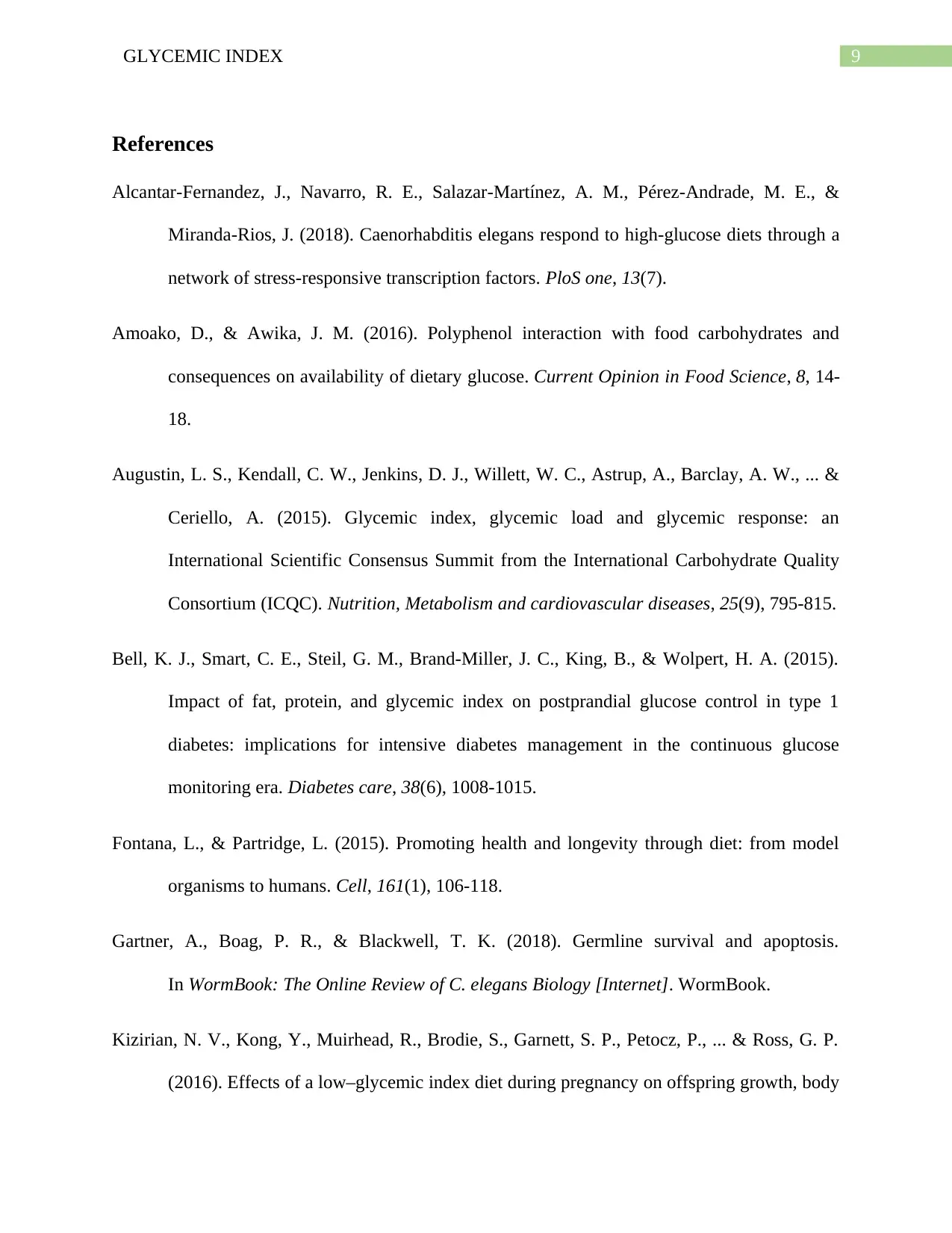
9GLYCEMIC INDEX
References
Alcantar-Fernandez, J., Navarro, R. E., Salazar-Martínez, A. M., Pérez-Andrade, M. E., &
Miranda-Rios, J. (2018). Caenorhabditis elegans respond to high-glucose diets through a
network of stress-responsive transcription factors. PloS one, 13(7).
Amoako, D., & Awika, J. M. (2016). Polyphenol interaction with food carbohydrates and
consequences on availability of dietary glucose. Current Opinion in Food Science, 8, 14-
18.
Augustin, L. S., Kendall, C. W., Jenkins, D. J., Willett, W. C., Astrup, A., Barclay, A. W., ... &
Ceriello, A. (2015). Glycemic index, glycemic load and glycemic response: an
International Scientific Consensus Summit from the International Carbohydrate Quality
Consortium (ICQC). Nutrition, Metabolism and cardiovascular diseases, 25(9), 795-815.
Bell, K. J., Smart, C. E., Steil, G. M., Brand-Miller, J. C., King, B., & Wolpert, H. A. (2015).
Impact of fat, protein, and glycemic index on postprandial glucose control in type 1
diabetes: implications for intensive diabetes management in the continuous glucose
monitoring era. Diabetes care, 38(6), 1008-1015.
Fontana, L., & Partridge, L. (2015). Promoting health and longevity through diet: from model
organisms to humans. Cell, 161(1), 106-118.
Gartner, A., Boag, P. R., & Blackwell, T. K. (2018). Germline survival and apoptosis.
In WormBook: The Online Review of C. elegans Biology [Internet]. WormBook.
Kizirian, N. V., Kong, Y., Muirhead, R., Brodie, S., Garnett, S. P., Petocz, P., ... & Ross, G. P.
(2016). Effects of a low–glycemic index diet during pregnancy on offspring growth, body
References
Alcantar-Fernandez, J., Navarro, R. E., Salazar-Martínez, A. M., Pérez-Andrade, M. E., &
Miranda-Rios, J. (2018). Caenorhabditis elegans respond to high-glucose diets through a
network of stress-responsive transcription factors. PloS one, 13(7).
Amoako, D., & Awika, J. M. (2016). Polyphenol interaction with food carbohydrates and
consequences on availability of dietary glucose. Current Opinion in Food Science, 8, 14-
18.
Augustin, L. S., Kendall, C. W., Jenkins, D. J., Willett, W. C., Astrup, A., Barclay, A. W., ... &
Ceriello, A. (2015). Glycemic index, glycemic load and glycemic response: an
International Scientific Consensus Summit from the International Carbohydrate Quality
Consortium (ICQC). Nutrition, Metabolism and cardiovascular diseases, 25(9), 795-815.
Bell, K. J., Smart, C. E., Steil, G. M., Brand-Miller, J. C., King, B., & Wolpert, H. A. (2015).
Impact of fat, protein, and glycemic index on postprandial glucose control in type 1
diabetes: implications for intensive diabetes management in the continuous glucose
monitoring era. Diabetes care, 38(6), 1008-1015.
Fontana, L., & Partridge, L. (2015). Promoting health and longevity through diet: from model
organisms to humans. Cell, 161(1), 106-118.
Gartner, A., Boag, P. R., & Blackwell, T. K. (2018). Germline survival and apoptosis.
In WormBook: The Online Review of C. elegans Biology [Internet]. WormBook.
Kizirian, N. V., Kong, Y., Muirhead, R., Brodie, S., Garnett, S. P., Petocz, P., ... & Ross, G. P.
(2016). Effects of a low–glycemic index diet during pregnancy on offspring growth, body
Paraphrase This Document
Need a fresh take? Get an instant paraphrase of this document with our AI Paraphraser
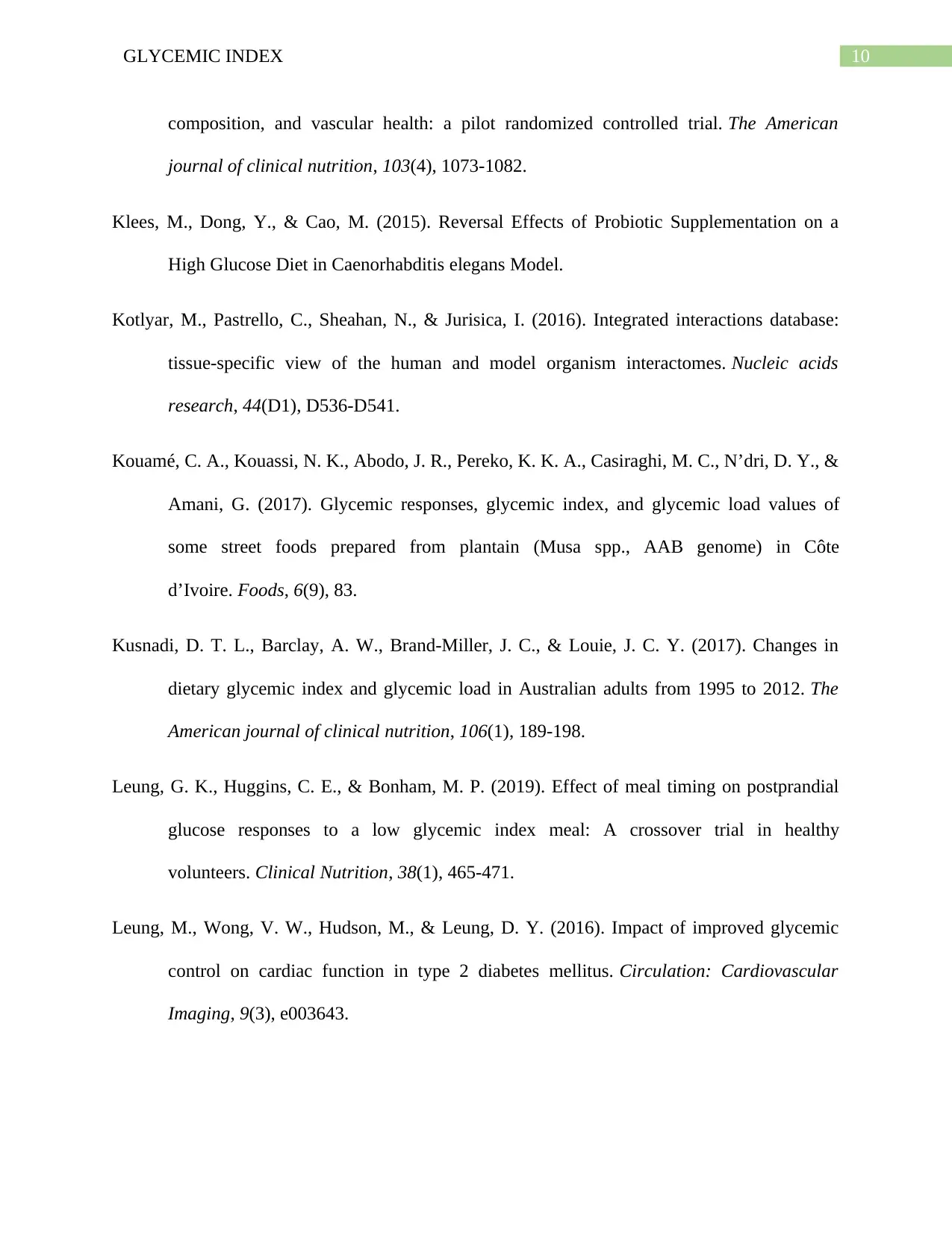
10GLYCEMIC INDEX
composition, and vascular health: a pilot randomized controlled trial. The American
journal of clinical nutrition, 103(4), 1073-1082.
Klees, M., Dong, Y., & Cao, M. (2015). Reversal Effects of Probiotic Supplementation on a
High Glucose Diet in Caenorhabditis elegans Model.
Kotlyar, M., Pastrello, C., Sheahan, N., & Jurisica, I. (2016). Integrated interactions database:
tissue-specific view of the human and model organism interactomes. Nucleic acids
research, 44(D1), D536-D541.
Kouamé, C. A., Kouassi, N. K., Abodo, J. R., Pereko, K. K. A., Casiraghi, M. C., N’dri, D. Y., &
Amani, G. (2017). Glycemic responses, glycemic index, and glycemic load values of
some street foods prepared from plantain (Musa spp., AAB genome) in Côte
d’Ivoire. Foods, 6(9), 83.
Kusnadi, D. T. L., Barclay, A. W., Brand-Miller, J. C., & Louie, J. C. Y. (2017). Changes in
dietary glycemic index and glycemic load in Australian adults from 1995 to 2012. The
American journal of clinical nutrition, 106(1), 189-198.
Leung, G. K., Huggins, C. E., & Bonham, M. P. (2019). Effect of meal timing on postprandial
glucose responses to a low glycemic index meal: A crossover trial in healthy
volunteers. Clinical Nutrition, 38(1), 465-471.
Leung, M., Wong, V. W., Hudson, M., & Leung, D. Y. (2016). Impact of improved glycemic
control on cardiac function in type 2 diabetes mellitus. Circulation: Cardiovascular
Imaging, 9(3), e003643.
composition, and vascular health: a pilot randomized controlled trial. The American
journal of clinical nutrition, 103(4), 1073-1082.
Klees, M., Dong, Y., & Cao, M. (2015). Reversal Effects of Probiotic Supplementation on a
High Glucose Diet in Caenorhabditis elegans Model.
Kotlyar, M., Pastrello, C., Sheahan, N., & Jurisica, I. (2016). Integrated interactions database:
tissue-specific view of the human and model organism interactomes. Nucleic acids
research, 44(D1), D536-D541.
Kouamé, C. A., Kouassi, N. K., Abodo, J. R., Pereko, K. K. A., Casiraghi, M. C., N’dri, D. Y., &
Amani, G. (2017). Glycemic responses, glycemic index, and glycemic load values of
some street foods prepared from plantain (Musa spp., AAB genome) in Côte
d’Ivoire. Foods, 6(9), 83.
Kusnadi, D. T. L., Barclay, A. W., Brand-Miller, J. C., & Louie, J. C. Y. (2017). Changes in
dietary glycemic index and glycemic load in Australian adults from 1995 to 2012. The
American journal of clinical nutrition, 106(1), 189-198.
Leung, G. K., Huggins, C. E., & Bonham, M. P. (2019). Effect of meal timing on postprandial
glucose responses to a low glycemic index meal: A crossover trial in healthy
volunteers. Clinical Nutrition, 38(1), 465-471.
Leung, M., Wong, V. W., Hudson, M., & Leung, D. Y. (2016). Impact of improved glycemic
control on cardiac function in type 2 diabetes mellitus. Circulation: Cardiovascular
Imaging, 9(3), e003643.
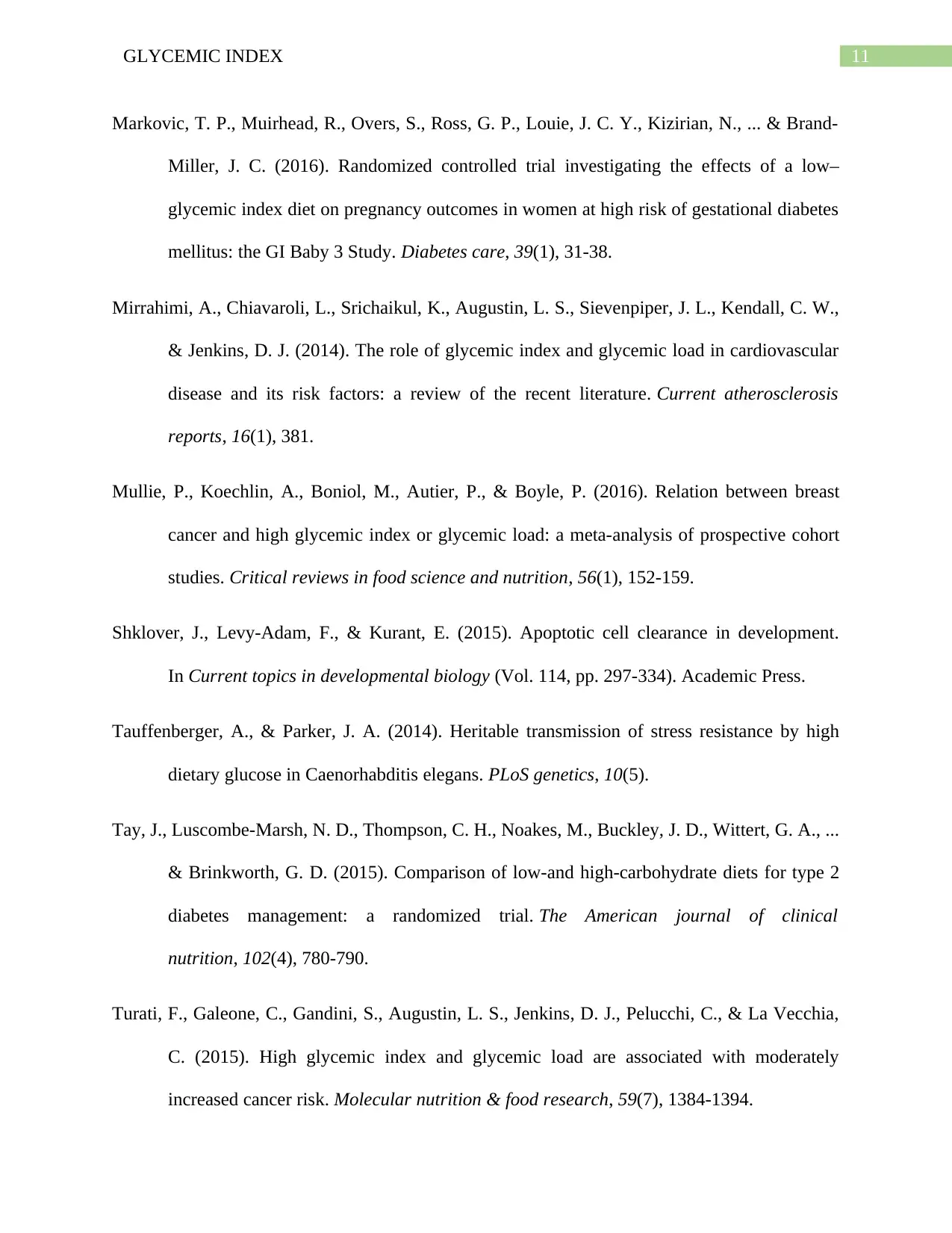
11GLYCEMIC INDEX
Markovic, T. P., Muirhead, R., Overs, S., Ross, G. P., Louie, J. C. Y., Kizirian, N., ... & Brand-
Miller, J. C. (2016). Randomized controlled trial investigating the effects of a low–
glycemic index diet on pregnancy outcomes in women at high risk of gestational diabetes
mellitus: the GI Baby 3 Study. Diabetes care, 39(1), 31-38.
Mirrahimi, A., Chiavaroli, L., Srichaikul, K., Augustin, L. S., Sievenpiper, J. L., Kendall, C. W.,
& Jenkins, D. J. (2014). The role of glycemic index and glycemic load in cardiovascular
disease and its risk factors: a review of the recent literature. Current atherosclerosis
reports, 16(1), 381.
Mullie, P., Koechlin, A., Boniol, M., Autier, P., & Boyle, P. (2016). Relation between breast
cancer and high glycemic index or glycemic load: a meta-analysis of prospective cohort
studies. Critical reviews in food science and nutrition, 56(1), 152-159.
Shklover, J., Levy-Adam, F., & Kurant, E. (2015). Apoptotic cell clearance in development.
In Current topics in developmental biology (Vol. 114, pp. 297-334). Academic Press.
Tauffenberger, A., & Parker, J. A. (2014). Heritable transmission of stress resistance by high
dietary glucose in Caenorhabditis elegans. PLoS genetics, 10(5).
Tay, J., Luscombe-Marsh, N. D., Thompson, C. H., Noakes, M., Buckley, J. D., Wittert, G. A., ...
& Brinkworth, G. D. (2015). Comparison of low-and high-carbohydrate diets for type 2
diabetes management: a randomized trial. The American journal of clinical
nutrition, 102(4), 780-790.
Turati, F., Galeone, C., Gandini, S., Augustin, L. S., Jenkins, D. J., Pelucchi, C., & La Vecchia,
C. (2015). High glycemic index and glycemic load are associated with moderately
increased cancer risk. Molecular nutrition & food research, 59(7), 1384-1394.
Markovic, T. P., Muirhead, R., Overs, S., Ross, G. P., Louie, J. C. Y., Kizirian, N., ... & Brand-
Miller, J. C. (2016). Randomized controlled trial investigating the effects of a low–
glycemic index diet on pregnancy outcomes in women at high risk of gestational diabetes
mellitus: the GI Baby 3 Study. Diabetes care, 39(1), 31-38.
Mirrahimi, A., Chiavaroli, L., Srichaikul, K., Augustin, L. S., Sievenpiper, J. L., Kendall, C. W.,
& Jenkins, D. J. (2014). The role of glycemic index and glycemic load in cardiovascular
disease and its risk factors: a review of the recent literature. Current atherosclerosis
reports, 16(1), 381.
Mullie, P., Koechlin, A., Boniol, M., Autier, P., & Boyle, P. (2016). Relation between breast
cancer and high glycemic index or glycemic load: a meta-analysis of prospective cohort
studies. Critical reviews in food science and nutrition, 56(1), 152-159.
Shklover, J., Levy-Adam, F., & Kurant, E. (2015). Apoptotic cell clearance in development.
In Current topics in developmental biology (Vol. 114, pp. 297-334). Academic Press.
Tauffenberger, A., & Parker, J. A. (2014). Heritable transmission of stress resistance by high
dietary glucose in Caenorhabditis elegans. PLoS genetics, 10(5).
Tay, J., Luscombe-Marsh, N. D., Thompson, C. H., Noakes, M., Buckley, J. D., Wittert, G. A., ...
& Brinkworth, G. D. (2015). Comparison of low-and high-carbohydrate diets for type 2
diabetes management: a randomized trial. The American journal of clinical
nutrition, 102(4), 780-790.
Turati, F., Galeone, C., Gandini, S., Augustin, L. S., Jenkins, D. J., Pelucchi, C., & La Vecchia,
C. (2015). High glycemic index and glycemic load are associated with moderately
increased cancer risk. Molecular nutrition & food research, 59(7), 1384-1394.
⊘ This is a preview!⊘
Do you want full access?
Subscribe today to unlock all pages.

Trusted by 1+ million students worldwide
1 out of 13
Your All-in-One AI-Powered Toolkit for Academic Success.
+13062052269
info@desklib.com
Available 24*7 on WhatsApp / Email
![[object Object]](/_next/static/media/star-bottom.7253800d.svg)
Unlock your academic potential
Copyright © 2020–2025 A2Z Services. All Rights Reserved. Developed and managed by ZUCOL.

